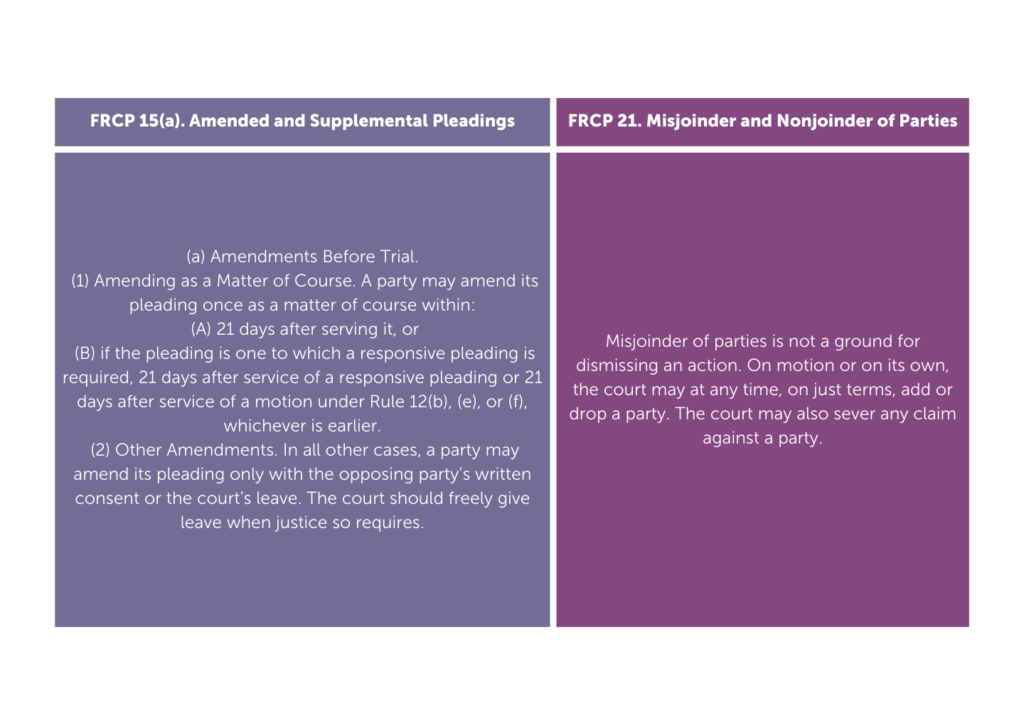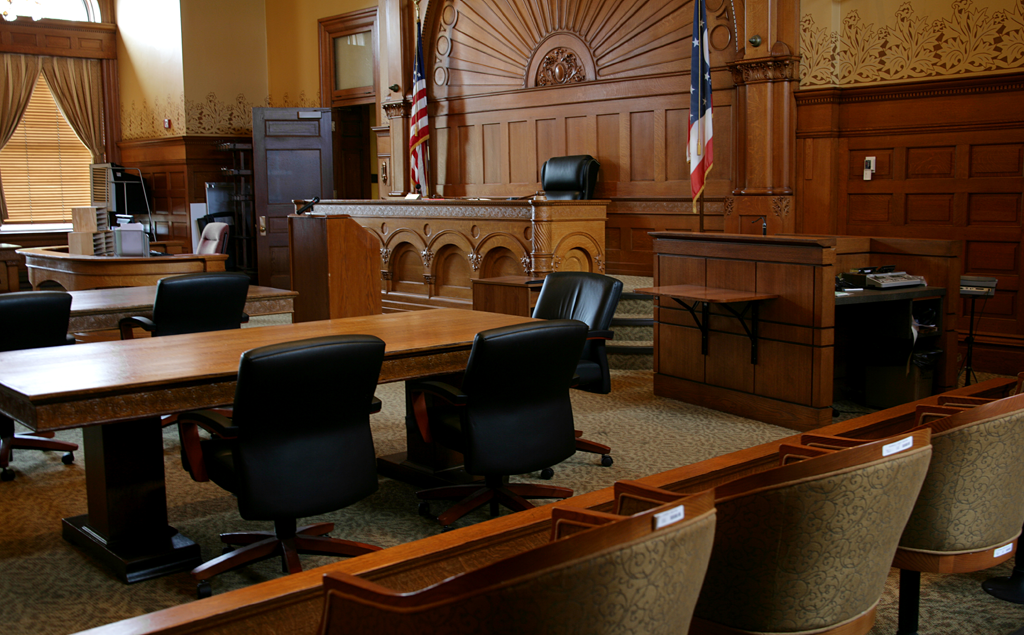
Introduction
The Federal Rules of Civil Procedure (FRCP) can be intricate and confusing, especially when it comes to the interplay between various rules. Few aspects of civil litigation present potential pitfalls such as amending and supplementing pleadings.
No matter how perfect a pleading may have been when it was filed, changing circumstances and newly emerging facts often require litigants to amend or supplement pleadings after filing. FRCP 15 establishes the guidelines for how and when litigants can amend and supplement pleadings in a pending case.
In this post, we’ll define FRCP 15 in more detail, explain what it requires, and explore how the 2015 amendments to FRCP 4 affect FRCP 15. Then, we’ll talk about when to apply FRCP 15 versus FRCP 21 when adding or dropping parties. Finally, we’ll share our top four ways to efficiently prepare for trial and explain how technology can help.
Contents
What is FRCP 15?
What does FRCP 15 allow?
- Amendments before trial
- Amendments during and after trial
- Relation back of amendments
- Supplemental pleadings
How do the 2015, 2016, and 2017 amendments to FRCP 4 affect FRCP 15?
Adding and dropping parties: Does FRCP 15 or FRCP 21 apply?
4 tips for efficient trial preparation
Technology can help you tell a compelling story
What is FRCP 15?
FRCP 15 is a shorthand name for Rule 15 of the Federal Rules of Civil Procedure, which allows parties to amend or supplement pleadings they have already filed with the court. FRCP 15 aims to streamline amendments, reducing the time and money parties spend arguing about amendments and increasing their chances of resolving the case on the merits. Rule 15 balances a flexible approach to amendments with limitations that ensure fairness for the opposing party.
What does FRCP 15 allow?
Rule 15 FRCP has four sections that cover amendments before, during, and after trial. It also addresses when amendments “relate back” to the initial pleading and the issue of supplemental pleadings. Here are the basic requirements of each section.
1. Amendments before trial
FRCP 15(a)(1) provides that a party may amend a pleading once without the court’s or the opposing party’s permission. This amendment must occur within 21 days of serving the pleading or—if the pleading at issue requires a responsive pleading—21 days after serving a responsive pleading or an FRCP 12(b), (e), or (f) motion (whichever happens earlier).
FRCP 15(a)(2) applies to all subsequent amendments, providing that a party may only amend a pleading with the opposing party’s written consent or the court’s permission. FRCP 15(a)(2) instructs that the court “should freely give leave [to amend pleadings] when justice so requires.”
2. Amendments during and after trial
Surely once a trial begins, pleadings are set in stone, right? Wrong. If an issue arises during trial and the opposing party objects to that issue as being outside of the pleadings, FRCP 15(b)(1) provides that “the court may permit the pleadings to be amended.” To do so, the court should evaluate whether adding the issue to the pleading would prejudice the opposing party. The court may also grant a continuance so that the objecting party can prepare for the newly added issue.
Under FRCP 15(b)(2), if an issue arises during trial and neither party objects to it, the parties and the court must treat the issue as if it had been included in the pleadings from the outset. In this situation, a party may move “to amend the pleadings to conform them to the evidence.”
3. Relation back of amendments
FRCP 15(c) considers how statutes of limitation apply to newly added claims in an amended pleading. It answers the question of whether parties can add new claims or parties to their pleadings after the statute of limitations that applies to the underlying action has run. If the statute of limitations has not yet run, FRCP 15(a) or (b) applies instead.
Under FRCP 15(c), the parties and the court can treat a new party or claim as if it had been in the original pleading—avoiding concerns about a statute of limitations that has passed—so long as it “relates back” to the date of the original pleading. Under FRCP 15(c)(1), an amendment relates back when:
- substantive law with the applicable statute of limitations explicitly allows relation back;
- new claim or defense arose out of the same “conduct, transaction, or occurrence” that the original pleading set out or attempted to set out; or
- amendment adds a new or differently named party and
- claim against that party arose out of the same “conduct, transaction, or occurrence” that the original pleading set out or attempted to set out;
- new party had notice of the action within the timeline under FRCP 4(m), preventing prejudice due to them having to defend against the claim at such a late date; and
- new party knew or should have known, within the timeline under FRCP 4(m), that they would have been named as a defendant “but for a mistake concerning the proper party’s identity.”
We’ll circle back to FRCP 4(m) and its requirements in a moment.
4. Supplemental pleadings
FRCP 15(d) allows the court to permit parties to add claims or defenses arising out of events that occurred after they filed the original pleading if they file a motion and provide reasonable notice. This is known as a supplemental pleading. The court may allow supplemental pleadings even when an original pleading is defective. The court may also order an opposing party to respond to the supplemental pleading within a certain timeframe.
Now that we’ve covered the basic requirements of FRCP 15, let’s talk about FRCP 4 and how the 2015 amendment to FRCP 4(m) affects FRCP 15(c)(1)(C).
How do the 2015, 2016, and 2017 amendments to FRCP 4 affect FRCP 15?
FRCP 4(m) requires plaintiffs to serve defendants within a certain timeframe after filing a complaint. The Supreme Court amended FRCP 4(m) in three consecutive years to correct an inadvertent conflict. The primary change occurred in the 2015 amendment, which reduced the service timeline from 120 to 90 days to hasten the initial stages of civil cases. However, if a plaintiff can show good cause for the failure to serve a defendant within 90 days, FRCP 4(m) requires the court to extend the timeline for service.
The 2015 amendment to FRCP 4(m) affects FRCP 15(c)(1)(C), which dictates whether a party may add a new or differently named party to a pleading after the statute of limitations has run. As explained above, whether a party may amend a pleading in that situation partially hinges on whether—within the timeline under FRCP 4(m)—the new party had notice of the action and knew or should have known that they would have been named as a defendant but for a mistake in the pleadings.
Therefore, as the Advisory Committee Notes for the 2015 amendment to FRCP 4 explain, “[s]hortening the time to serve under Rule 4(m) means that the time of the notice required by Rule 15(c)(1)(C) for relation back is also shortened.” If the court grants an extension for good cause, the timeframe under FRCP 15(c)(1)(C) expands accordingly.
When it comes to adding and dropping parties, FRCP 15 is not the only rule that matters. FRCP 21 may also apply in certain situations, as we’ll explore next.
Adding and dropping parties: Does FRCP 15 or FRCP 21 apply?
In most cases, FRCP 15(a) is the section of FRCP 15 that applies to adding or dropping parties. But the issue of whether FRCP 15(a) or FRCP 21 applies is a bit more complicated. Here are the two rules compared:

As you can see, both rules require the court to decide whether to allow or deny a proposed amendment. Further, both rules provide liberal standards for amending pleadings. There is no great functional difference between the two rules, but courts vary on whether they apply FRCP 15 or FRCP 21. Therefore, the best approach is to consider both rules in your briefs and arguments to cover your bases.
As trial draws nearer, you’ll need to shift your attention to trial preparation. Here are our top four tips for efficient trial preparation.
4 tips for efficient trial preparation
Trial preparation can be extremely lengthy and complex. That’s why you need to work efficiently to get everything done on time. Here are our top four tips for efficient trial preparation.
1. Communicate effectively
As a litigator, you work with clients as well as outside counsel, paralegals, legal assistants, expert witnesses, and others. Clear communication is necessary for efficient trial preparation because it ensures each person on your team knows what to do and how to help when issues arise. Miscommunication, on the other hand, can lead to wasted time and resources, errors, and damage to your case and reputation. By communicating effectively, you can avoid these pitfalls and make sure trial preparation goes smoothly.
2. Know your judge
Judges are supposed to be impartial. But judges are people, too, and they bring their backgrounds, viewpoints, and idiosyncrasies to the courtroom. Knowing your judge’s personality, level of flexibility, and track record with previous cases like yours can help you prepare your pre-trial motions and case accordingly and avoid wasting time on arguments that won’t fly. If you aren’t familiar with your judge based on first-hand experience, consult with your colleagues and other attorneys about their experiences.
3. Craft a compelling story
Crafting a strong, compelling narrative is an integral part of trial preparation. Without a believable story that emphasizes the facts that are most favorable to your client, it is nearly impossible to win a case. Focusing on the story you are telling can also make your trial preparation process more efficient because it helps you identify the evidence you need to focus on and avoid the distraction of irrelevant evidence.
4. Leverage technology
Technology can help you craft a compelling narrative and proceed with confidence. The right tools can help you organize your materials, prioritize the most important evidence, and effectively communicate and collaborate with others.
For example, IPRO’s TRIAL DIRECTOR platform allows you to create and streamline the story you want to tell and give winning trial presentations. TRIAL DIRECTOR does this by helping you pinpoint the most convincing evidence at your disposal and summarize it in a captivating way. The platform displays exhibits quickly and seamlessly, whether you want to pull up sections of documents, create video clips, or present a side-by-side comparison of evidence.
TRIAL DIRECTOR also provides central case storage, real-time data syncing, and document access control so you can securely communicate and collaborate with your team.
Technology can help you tell a compelling story
Understanding the contours of FRCP 4, FRCP 15, and FRCP 21 can allow you to refine your pleadings before, during, and after trial and increase your chances of winning your case. But efficiently preparing for trial and creating a compelling narrative for your audience are the steps that pull it all together.
Technology is the key to efficient trial preparation and storytelling. With the right technology, you can synthesize all of your relevant evidence on time, avoid unnecessary expenses, and increase your chances of winning at trial. That adds up to happy clients and ultimately more business.
To learn more about IPRO and TRIAL DIRECTOR, get in touch with us and schedule a demonstration.



